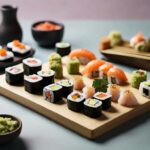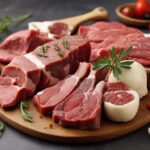The evolution of cuisine is a fascinating journey that immerses us in the richness of culinary traditions and the innovation that defines how we understand and enjoy food. Throughout history, cuisine has evolved from being a mere necessity for survival to becoming an art form, a cultural expression that reflects the identity of communities and eras.
In this detailed analysis, we will explore the intriguing contrast between traditional cuisine and modern cuisine. Traditional cuisine, rooted in local customs and recipes passed down through generations, serves as a reminder of the deep connection between food and cultural identity. On the other hand, modern cuisine, with its emphasis on innovation and experimentation, has taken gastronomy to new heights, challenging expectations and expanding the boundaries of what we consider food.
As we delve into this analysis, we will discover how the evolution of cuisine encompasses not only recipes and techniques but also ingredients, presentation, and fundamentally, how we understand the act of eating. In a world that embraces both the ancestral and the avant-garde, we will explore how these two facets of cuisine coexist and complement each other, creating a diverse and exciting culinary canvas. Join us on this journey through the evolution of cuisine, where tradition and modernity converge to delight our senses and enrich our understanding of gastronomy.
Traditional Cuisine: A Link to the Past
Delving into traditional cuisine is to explore the very roots of a culture. Over the centuries, traditional cuisine has been the epicenter of knowledge transmission, values, and above all, stories. In this detailed analysis, we will unravel the elements that make traditional cuisine such a significant link to our culinary past.
Traditional cuisine is characterized by its roots in local customs and the use of ingredients that reflect geography and seasonal availability. Each dish tells a story that goes beyond its ingredients; it is a testimony to a community’s history, its traditions, and its relationship with the land that nourishes it.
Recipes Passed Down from Generation to Generation
At the heart of traditional cuisine lies the oral transmission of recipes, a legacy passed from grandmothers to mothers, from fathers to children. Each generation brings its unique touch, but the essence of the recipes remains intact, creating a bridge between the past and the present.
Simple Cooking Methods and Rooted Techniques
The cooking methods in traditional cuisine are testaments to simplicity and effectiveness. From the slow simmering of stews to the expert use of herbs and spices, each technique has deep roots in functionality, the result of centuries of refinement.
Reflection of Cultural Identity
Traditional cuisine goes beyond food preparation; it is an expression of cultural identity. Local ingredients, native flavors, and transmitted recipes reflect a community’s connection to its environment and how they have adapted their cuisine over time.
Adaptability to Seasonal Availability
Traditional cuisine adapts to the seasonal availability of ingredients, celebrating the freshness and variability of each season. This approach not only ensures a balanced diet but also highlights the importance of respecting and working in harmony with nature.
Exploring traditional cuisine is immersing oneself in a culinary journey that embraces history, community, and authenticity. Each dish tells a unique and timeless story, reminding us that, despite changes, the essence of traditional cuisine remains an unbreakable link to our past and an endless source of inspiration in the present.
Modern Cuisine: Innovation and Creativity
In contrast to the deep-rooted tradition of cuisine, modern cuisine stands as a beacon of innovation and creativity. This culinary segment has undergone a revolutionary transformation, challenging established norms and exploring new boundaries in the constant pursuit of gastronomic excellence. Let’s delve into the fascinating world of modern cuisine, where creativity and technology converge to redefine our perception of food.
Emphasis on Technological Innovation
Modern cuisine embraces technology as a fundamental tool for culinary innovation. From state-of-the-art kitchen equipment to advanced techniques such as sous vide cooking and the application of liquid nitrogen, technology has become an ally in creating unique gastronomic experiences.
Experimentation with Cutting-Edge Techniques
Chefs in modern cuisine are true alchemists, experimenting with cutting-edge techniques that defy expectations. Molecular gastronomy, foaming, and dehydration are just some of the techniques that have redefined the presentation and texture of dishes, creating unforgettable sensory experiences.
Globalization and Flavor Fusion
Modern cuisine transcends borders, blending flavors from diverse culinary traditions. Globalization has allowed chefs to experiment with exotic ingredients and techniques from around the world, resulting in an international flavor palette that awakens the senses and challenges palates.
Importance of Visual
Presentation In modern cuisine, presentation is as crucial as the taste itself. Dishes become works of art, with striking visual presentations that seek to surprise and captivate. Aesthetics become an integral part of the gastronomic experience, elevating food to an artistic expression.
Modern cuisine is fertile ground for experimentation, where creativity knows no bounds. From adapting scientific techniques to creating dishes that defy conventions, this groundbreaking approach constantly redefines what we understand as good cuisine. In this fascinating journey, modern cuisine invites us to delight our senses and question our perceptions, offering an exciting and contemporary vision of culinary art.
Evolution of Ingredients and Techniques
The evolution of cuisine is not only manifested in recipes but also in the selection of ingredients and preparation techniques that have undergone notable transformations over time. This dynamic aspect of gastronomy reflects how cuisine adapts, innovates, and adopts new approaches to create unique and surprising culinary experiences.
Variety of Ingredients in Modern Cuisine
Modern cuisine is distinguished by the diversity of ingredients available to chefs. As the world becomes more accessible, cooks can incorporate exotic and uncommon ingredients, exploring new frontiers of flavors and textures. From exotic fruits to lesser-known herbs, the palette of ingredients has expanded enormously.
Precise and Cutting-Edge Techniques
Preparation techniques in modern cuisine are a fascinating blend of tradition and innovation. While classic techniques like sous vide or smoking offer consistent and delicious results, cutting-edge techniques such as 3D food printing or controlled fermentation represent the frontier of culinary innovation.
Fusion of Tradition and Modernity in Current Cuisine
The evolution of cuisine has led to an interesting fusion of traditional ingredients and techniques with modern approaches. Contemporary chefs seek to balance the authenticity of traditional recipes with the creativity of modern cuisine. This translates into dishes that respect cultural roots but incorporate unexpected touches.
Adaptation to Dietary Preferences
The evolution of cuisine is also evident in adapting to changing dietary preferences. With a growing focus on health and sustainability, chefs explore healthier and more creative cooking techniques, using fresh and nutritious ingredients in innovative combinations.
The evolution of ingredients and techniques in cuisine is a reflection of human creativity and adaptability. From the simplicity of local ingredients in traditional cuisine to the complexity of cutting-edge techniques in modern cuisine, each change has contributed to the richness and diversity of gastronomy. This constant flow of innovation and tradition defines contemporary cuisine and promises to continue inspiring our taste buds in the future.
Changes in Tastes and Preferences
The evolution of cuisine is not only evident in ingredients and techniques but also in the dynamic landscape of gastronomic tastes and preferences. As society undergoes cultural and social changes, diners’ palates evolve, shaping new trends at the table. This detailed analysis explores how the evolution of cuisine has influenced tastes and preferences, transforming the way we conceive and enjoy food.
Exploration of International Flavors
Globalization has had a significant impact on gastronomic tastes, leading to greater exploration of international flavors. Modern diners seek authentic culinary experiences from diverse cultures, leading to an openness to ingredients and cooking techniques once considered exotic.
From Traditional to Innovative
As cuisine evolves, tastes shift from traditional to innovative. Diners seek dishes that offer unique experiences, whether through creative presentation, unusual ingredient combinations, or modern reinterpretations of classic recipes.
Emphasis on Health and Sustainability
Growing awareness of health and sustainability has transformed dietary tastes and preferences. Modern diners value healthier options such as fresh ingredients, organic foods, and nutritionally balanced dishes. Sustainability has also become a key criterion when choosing ingredients and cooking techniques.
Demand for Culinary Experiences
The gastronomic experience has become as important as the taste itself. Diners seek not only to satisfy their appetite but also to enjoy a complete experience. Artistic presentation, ambiance, and the story behind each dish are increasingly influencing restaurant and recipe choices.
The evolution of tastes and preferences in cuisine reflects the diversity and adaptability of society. From the search for cultural authenticity to concerns about health and sustainability, these changes reveal an intrinsic connection between food and social trends. This dynamism in tastes promises to continue shaping gastronomy, taking it to new horizons of creativity and sensory satisfaction.
Conclusions
The exploration of the evolution of cuisine, from deep-rooted tradition to bold innovation, reveals a fascinating narrative that spans centuries of cultural and social changes. The duality between traditional and modern cuisine does not represent a dichotomy but rather a symphony of flavors, techniques, and experiences that enrich our understanding of gastronomy.
The Synthesis of Tradition and Modernity
At the intersection of traditional and modern cuisine, we find a synthesis rich in nuances. Contemporary cuisine does not reject its roots but embraces and transforms them. Chefs, as culinary artisans, have managed to harmonize the old with the new, creating dishes that respect cultural heritage while exploring uncharted territories.
The Importance of Creativity and Innovation
Modern cuisine, with its emphasis on creativity and innovation, challenges us to rethink our relationship with food. Experimentation with cutting-edge techniques, the fusion of international flavors, and visual presentation underscore that cuisine is, above all, an artistic expression that evolves over time.
Adaptation to Changing Preferences
The evolution of ingredients and techniques is not just a matter of fashion but a response to changing diner preferences. Globalization, health consciousness, and sustainability have driven a revolution in gastronomic tastes, making cuisine more diverse, accessible, and thoughtful.
Food as a Complete Experience
The transformation in tastes and preferences also highlights the growing importance of the complete gastronomic experience. Food has become a sensory event where presentation, ambiance, and the narrative behind each dish intertwine to create unforgettable moments around the table.
In conclusion, the evolution of cuisine is a continuous journey that connects generations, cultures, and trends. The richness of this evolution lies in its ability to unite the old and the new, the traditional and the innovative. As we continue to explore culinary diversity, it becomes clear that cuisine is more than sustenance; it is a dynamic expression of human creativity that will continue to delight and surprise us in the future.
Explore our e-shop and take your culinary experience to the next level! At CookingLandia, we have carefully selected the finest kitchen utensils and products for you. From high-quality chef’s knives to durable cookware, and innovative culinary gadgets, you’ll find everything you need to equip your kitchen like a true professional. Discover our curated collection and choose the products that will make cooking even more exciting and efficient. Visit our e-shop now and turn every moment in the kitchen into an extraordinary experience! 🍳🔪🍴
More content
- Gastronomía egipcia: dieta y recetas ancestrales

- Comida Callejera en el Mundo: Historia y Platos Típicos

- Historia del Chocolate: De los Aztecas al Presente

- Culinary Globalization: Exploring 6 Iconic World Dishes

- Sustainable Dishes: Gastronomic Trends for a Greener Future

- The Most Impactful Gastronomic Trends Shaping the World

- Myths and Legends: The Magical Stories Behind Foods

- Symbolism of Food: The Meaning in Every Bite

- Iconic Dishes of Spanish Cuisine by Region

- Exploring Flavors: Top 10 Typical Dishes of Latin America

- Perfect Pairing: Wines and Dishes for Gastronomic Celebrations

- Title: Culinary Traditions in Festivals: Festive Flavors of the World

- Gastronomy and Folklore: Culinary Traditions and Local Myths

- Culinary Journey: Discovering Culinary Traditions from Different Cultures

- Healthy and Affordable Recipes: Eating Well Without Spending Much

- Healthy Breakfasts: 7 Nutritious Recipes for the Whole Week

- Probiotic Foods: How Do They Improve Your Digestive Health?

- Boost Your Immune System: The Best 10 Foods

- 6 Healthy Recipes for a Balanced and Delicious Diet

- 15 Foods to Maintain a Balanced and Nutritious Diet

- Menus for Allergen-Free Diets: The Best Recipes and Nutritional Strategies

- Dietary Plans for Food Allergies: Top 10 Tips and Recommendations

- Low-Carb Diets: Top 10 Recommended Foods

- Low-Carb Diet: A Beginner’s Guide

- Easy Gluten-Free Recipes for Every Day of the Week

- Complete Guide to Gluten-Free Diets: Tips for Beginners

- Protein Sources in a Vegan Diet: What to Do?

- Vegetarianism for Beginners: Simple Steps to Adopt This Lifestyle

- Taste the Best of Africa: Top 5 Iconic Regional Recipes

- The Secrets of African Cuisine: Traditional Recipes and Flavors

- 10 Latin American Sweets: Tempting Dessert Adventures Await

- Secrets of Latin American Cuisine: Traditional and Authentic Recipes You Must Try

- Taste of the Mediterranean: 5 Key Dishes

- Simple Mediterranean Cooking for Beginners: Impress Your Guests!

- Homemade Sushi: Simple Steps to Prepare Your Favorite Rolls

- Secrets of Asian Cuisine: Discovering 8 Traditional Techniques

- Innovation in Cuisine: Gourmet Products in Traditional Recipes

- The 10 Most Exclusive Gourmet Products You Must Try

- White Fish vs. Blue Fish: Which is Better for Your Health?

- The Secrets of Perfect Seafood Cooking: Kitchen Tricks

- How to Choose the Best Poultry for Your Recipes

- From Farm to Table: How to Select Quality Meat

- Complete Guide: Enhance Your Dishes with Fresh Herbs

- Revealing the Superfood Potential of Red Fruits: Benefits & Recipes

- Starting Out in the Kitchen: Pro Chef Tips for Beginners

- Unlock Your Culinary Potential: Beginner’s Guide to Essential Techniques

- Culinary Secrets Unveiled: Elevate Your Cooking with Simple Ingredient Tricks

- Master Your Kitchen: 10 Unexpected Tips for Easy Cooking

- Art of Fruit and Vegetable Cutting: Expert Techniques Revealed

- Efficiency Unleashed: Explore the Art of Mise en Place

- Mastering Healthy Cooking: Unveiling 4 Low-Fat Secrets

- Complete Guide to Cooking Methods: Everything You Need to Know

- From Fusion to Tradition: 4 Global Gastronomic Trends

- Culinary Innovations: The Most Impactful Gastronomic Trends

- A Gastronomic Journey: Migratory Influences in the Cuisine

- Flavors of the World: A Journey Through Diverse Culinary Influences

- The Evolution of Food: Traditional vs. Modern Cuisine Compared

- The Great Masters of Cuisine: Contributions to its Evolution

- Spices Through Time: Understanding Their Historical Importance

- 5 Great Gastronomic Moments: Historic Milestones in the Cuisine


